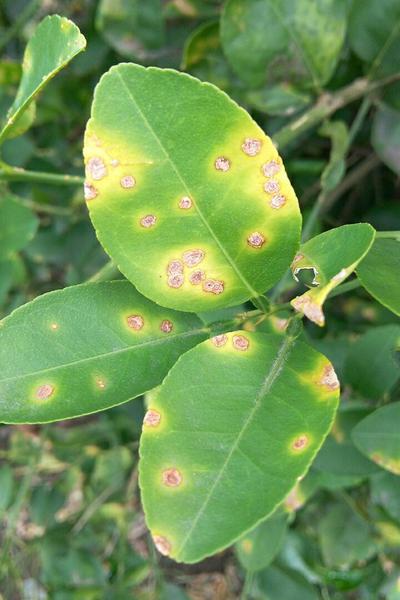Citrus Canker
Xanthomonas axonopodis pv. citri
Bacteria
In a Nutshell
- Rust-brown, wart-like craters surrounded by yellow halo on leaves.
- Later lesions with light brown or gray centers with oily, water-soaked brownish margin.
- Similar symptoms on fruit and twigs.
Can also be found in
Symptoms
Trees can be affected at all stages of their development and symptoms may appear on leaves, fruits or twigs. Tiny, slightly raised and spongy lesions develop first on both surfaces of newly-infected leaves. As they mature, these spots develop into rust-brown wart-like craters that are surrounded by a distinctive bright yellow halo. They eventually erupt, releasing their content, and forming a typical lesion with a light brown or gray center and oily, water-soaked brownish margin. Occasionally, the center of old cankers fall out, leaving behind a shot-hole effect. Similar symptoms can appear on fruits and twigs, where the cankers can reach a sizable dimension. The center of the lesion becomes characteristically raised, scabby or corky. Defoliation and premature fruit drop ensue and twigs may be killed by girdling of vascular tissues. Fruits that reach maturity are not marketable.
Recommendations

Organic Control
Unfortunately, no effective biological control methods are available at this time.

Chemical Control
Always consider an integrated approach with preventive measures together with biological treatments if available. Unfortunately, there is no effective control on citrus canker once it has been detected. Preventive measures such as the clearing and destruction of fallen tree material are essential to minimize the effect of the disease. The control of citrus psyllids can also be a way to limit the damage. Copper-based fungicides or bactericides can provide a barrier against infection, but they will not treat an existing infection.
What caused it?
Citrus canker is a serious and highly contagious disease of commercial varieties of citrus and relatives. It is caused by the bacteria Xanthomonas citri, which can survive for periods of over 10 months in old lesions on fruits, leaves, and stems. It enters the plant’s tissues through wounds or natural pores in the leaf surface and grows there systemically. The craters that form on leaves and other tissues contain bacteria, that are released when wet and spread by rain splash or overhead irrigation systems over short distances. Conditions that favor the disease are high humidity, hot (20 to 30 °C) and rainy weather conditions, ideally with strong winds. Citrus psyllids, leaf miners, birds, as well as infected tools and equipment can also transmit the bacteria between trees or groves. Finally, the movement of infected plants or plant parts such as nursery trees or propagation material is also a problem.
Preventive Measures
- Check for quarantine regulations in the area.
- Chose citrus varieties that are more resistant to the disease.
- Be sure to buy healthy plant material, if possible from certified sources.
- Monitor the trees for signs of the disease.
- Prune away the part of the trees that are infected during the dry season.
- Sterilize tools and equipment between uses to prevent the spread of the disease.
- Do not work in the field when foliage is wet.
- Clean boot, clothes thoroughly when working between different orchards.
- Destroy severely infected trees to prevent infecting healthy trees nearby.
- Remove fallen leaves, fruits, and branches from the ground and destroy them.
- Use windbreaks between fields to avoid propagation.



